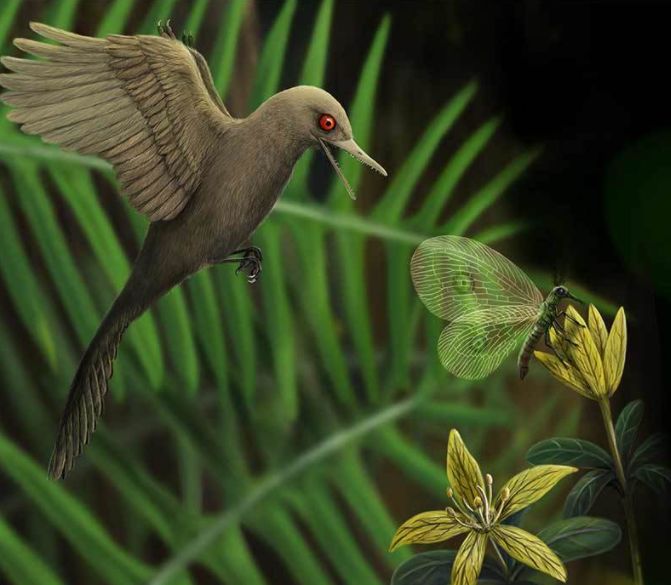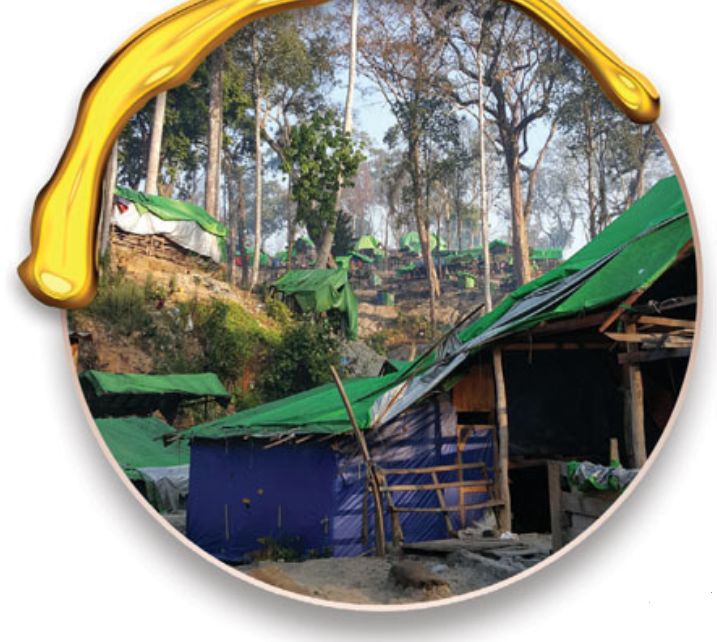Startling fossils in amber defy long-age dogmas

Often referred to as ‘nature’s time capsule’, amber offers fascinating glimpses into the past due to the stunning level of preservation of creatures fossilized in it. It is a valuable tool in examining which history, creation or evolution, offers a better explanation of today’s world. As we will see, amber continually confounds evolution’s long war against God on multiple fronts.1
How is amber formed?
Amber is fossilized tree resin, usually from conifer trees. Resin is part of a tree’s defence (immune) system. When the tree is damaged by animals, insects, the weather, or people, it releases the sticky resin. This plugs up the ‘wound’, which seals and sterilizes it. It prevents any insects or fungi entering the tree through the damaged section. After oozing out, the sticky resin left exposed to the elements can degrade and weather away once it has done its job (think of a scab).
For the resin to become amber, it first needs to be buried, where it begins to harden and is called copal. As more heat and pressure are applied, chemical transformation occurs, completing its journey to amber. It is regularly claimed by evolutionists that amber takes millions of years to form. However, as they occasionally admit, “it’s not sure how long the process to turn resin into amber actually takes.”2 The following examples together show that the Bible’s history and timeline fit the facts better than the evolutionary one.
1. Beetles largely unchanged for ‘99 million years’

(A,B) Under green epifluorescence;
(C) under normal reflected light.
Five well-preserved beetles belonging to the Clambidae family have been found in Myanmar amber (fig. 1) and assigned to two new species. Allegedly 99 million years old, the tiny beetles Acalyptomerus thayerae (c. 1.1 mm long) and Sphaerothorax uenoi (c. 0.7 mm) were placed in living genera.3 A report said the beetles were “extremely morphologically close to their living counterparts”, and that the “similarities between fossil and living species suggest that both genera changed little over long periods of geological time”.4

BELOW: Despite only the head being preserved in amber (see figure 5), a full-body reconstruction was also undertaken, in a hummingbird-style pose. Neither warranted the headline of hummingbird-sized dinosaur.
They went on to say that in all, ten beetle species belonging to living genera had been found in amber. These had also “changed very little over long evolutionary history”. They further stated, “It is obvious that the body plans of many extant beetle lineages have been established and remained almost unchanged from the mid-Cretaceous, some 99 Ma.”3
Evolution is supposed to be about ongoing small gradual changes adding up to big ones over time. Therefore something staying much the same for vast ages (‘stasis’) needs to be explained away. For the two new Clambidae beetles, the researchers claimed this was due to their particular habitat—decaying vegetation, leaf litter, and rotten wood—persisting over those 99 million years. But of course, many creatures whose habitat would also have stayed much the same (e.g. the deep sea) are supposed to have dramatically changed in similar timespans. In those cases, evolutionists would argue that a creature’s environment includes its predators, food, and competitors. And these, they say, have been constantly changing as they supposedly evolve.
So evolutionists consistently try to have it both ways. They use neo-Darwinism to explain both alleged change and the absence of change, depending on what suits. But as philosophers of science have pointed out, a theory flexible enough to explain everything, including contrary outcomes, really explains nothing. Taken at face value, ‘stasis’ is evidence against evolution, and creatures not changing much at all over a few thousand years fits well with biblical history.
2. Stunning caterpillar in amber shows no evolution

The first ever caterpillar of its family (Geometridae) found in Baltic amber (fig. 2) was reported in 2019.5 Five mm (⅕″) long, Eogeometer vadens, like all geometrids, has three pairs of prolegs6 rather than the more common five pairs.
These caterpillars move in a very distinctive manner called looping. They push their rear legs towards their front ones, the middle of the body looping upwards, and then stretch their body out to the front again. This specimen is stuck in this typical looping position in the amber. The researchers point out how incredible this fossil find is, since caterpillars, having no hard tissues, are “exceptional findings, even in amber”.
The assigned ‘age’, 44 million years, again presents the issue of evolutionary stasis. The body plan of geometrid caterpillars, and their unique locomotion, has not changed in this alleged long period of time. This is again consistent with biblical creation, not evolution.
3. Cave-dwelling cockroaches in amber

Two new species of exquisitely preserved cockroaches, specially adapted for living in cave environments, have been identified in Myanmar amber.7 Named Crenocticola svadba and Mulleriblattina bowangi, they were placed in the Nocticolidae family (fig. 3). The amber is ‘dated’ to be an alleged 99 million years old, making the cockroaches the oldest cave-dwelling (‘troglomorphic’) animals ever discovered.
As well as their compact size (less than 5 mm) they also share typical features with modern cave-dwelling cockroaches such as: small eyes, extremely long antennae, paler pigmentation, and reduced wing size. The specimens were found amongst more than 100 tonnes of amber removed from a mine in the Hukawng Valley.
As trees are not found inside dark caves, the researchers suggested two possibilities for the resin which trapped the cockroaches. It was either from a tree growing at the cave’s edge while they were transiting between caves, or it had dripped from tree roots into their cave.8 However, neither of these scenarios sounds plausible, nor fits with the huge amount of amber in the deposits they were found in.
4. Amber-encased insect attached to dinosaur jaw

BOTTOM: The trapped aphid insect and corresponding diagram
A two-for-one fossil (fig. 4) has been discovered in Dinosaur Provincial Park, Alberta, Canada.9 A 7-cm–wide chunk of amber containing an aphid, a sap-sucking insect, was stuck to a jawbone from a hadrosaur dinosaur, Prosaurolophus. The researchers hypothesized that the jawbone and the fresh sticky resin (in which the insect had just been trapped), both just happened to be washed into a river at the same time where they came into contact. No wonder it was referred to as an “incredibly unlikely chain of events”.10
5. Bird skull found in amber
While described in the sensationalist title of the research paper as a “hummingbird-sized dinosaur”,11 in reality a bird skull has been identified in Myanmar amber (fig. 5). Named Oculudentavis khaungraae, its skull is just under 1.5 cm (0.6“) long, so is thought to rival the bee hummingbird as the smallest known bird. From its bone growth the research team identified it as an adult, and noted some unusual features (bones within the eye not square but spoon-shaped, and likely an unusual appearance from eyes that probably bulged out of its head). They stated that one reason for these could be “the effects of miniaturization”. Of course, its distinct features may well have been present when it was created on Day 5, becoming subsequently extinct.

But sometimes what is not said in a journal article is as (or more) important than what is. The researchers made no attempt to explain how a decomposed, decapitated bird skull came to be trapped in amber along with a range of gastropods (snail shells), insects and plant material.
Noah’s Flood—the key to understanding amber


All five of these fantastic fossils are much better explained by the global Flood some 4,500 years ago. At the start of the Flood, forests were ripped up by the turbulent waters. As the trees travelled together, they would have smashed against one another, releasing large quantities of resin. As the extremely sticky resin can float in water it would have trapped and encased any small items that were also in the water. This explains the wide range of insects, small animals, and plant material (and sometimes marine fossils) included in it from a considerable range of environments. It would also account for how some stuck to the dinosaur jaw bone which was also being swept along in the Flood waters. Large amounts of the resin were then deposited and buried rapidly under huge quantities of sediment, which provided the pressure and heat required for its chemical transformation into amber. This Flood scenario also explains why we find amber in such large deposits, quite different from what would be expected by a tree here and there oozing resin in a normal situation.
The circumstances in which amber is found, and the inclusions inside, frustrate the evolutionary dogma of long ages. Such finds don’t point to tens of millions of years of evolutionary stasis, or droplets of resin falling from tree roots into a cave. They are instead like ‘God’s time capsules’, testifying to a huge catastrophic event in which large amber deposits formed—namely, the watery judgment He sent upon the earth around 4,500 years ago.
References and notes
- See e.g. Robinson, P., Ammonite in amber, Creation 42(2):44–45, 2020. Return to text.
- Motivans, E., How amber forms nature’s time capsule. It takes millions of years! Zmescience.com, 4 Jul 2017. Return to text.
- Cai, C. and 8 others, Basal polyphagan beetles in mid-Cretaceous amber from Myanmar: biogeographic implications and long-term morphological stasis, Proc. Royal Soc. B 286:20182175, 16 Jan 2019. Return to text.
- Chinese Academy of Sciences, Two tiny beetle fossils offer evolution and biogeography clues; phys.org, 18 Jan 2019. Return to text.
- Fischer, T.C. and 2 others, Geometrid caterpillar in Eocene Baltic amber (Lepidoptera, Geometridae). Sci. Rep. 9:17201, 20 Nov 2019. Return to text.
- All caterpillars have three pairs of true (segmented) legs in addition to such cylindrical pairs of ‘prolegs’. Return to text.
- Sendi, H. and 8 others, Nocticolid cockroaches are the only known dinosaur age cave survivors, Gondwana Research 82:288–298, Jun 2020. Return to text.
- Letzter, R., ‘Exquisite’ dinosaur-age cockroaches discovered preserved in amber; livescience.com, 2 Mar 2020. Return to text.
- McKellar, R.C. and 8 others, A direct association between amber and dinosaur remains provides paleoecological insights, Sci. Rep. 9:17916, 2019. Return to text.
- Pickrell, J., ‘Remarkable’ fossil features an insect trapped in amber, stuck to a dinosaur jaw; sciencemag.org, 29 Nov 2019. Return to text.
- Xing, L. and 6 others, Hummingbird-sized dinosaur from the Cretaceous period of Myanmar, Nature 579: 245–249, 2020. Return to text.





Readers’ comments
Comments are automatically closed 14 days after publication.